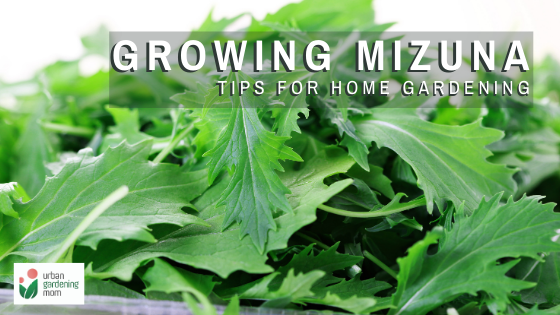
Home-grown Mizuna - Tips and Tricks for Growing and Harvesting
- Oct 17, 2020
- 0 Comment(s)
Do you know that you can grow Mizuna practically all-year round here in the Philippines?
Mizuna is most popular in Japan and is used in salad mixes and other Japanese dishes. It is usually grown in colder climate zones where it thrives well even in near-zero temperatures. In the Philippines, we can now grow Mizuna using a heat-resistant variety that can thrive even in the lowlands, such as in Metro Manila.
That is one good reason why you should include this in your urban garden. With proper care, it takes only about 2 -3 weeks to grow and re-grow well when harvested as a cut-and-come-again green.
Also, if you’re looking for a healthy leafy green to add to your recipe, Mizuna is a good example as it is rich in vitamins A, C, and K, as well as beta carotene.

What is Mizuna?
According to Wiki, Mizuna which literally means “water greens,” has been cultivated in Japan since ancient times. Mizuna is similar to cabbage, kale, brussels sprouts, carrots, and celery which we usually harvest in their first season of vegetative growth.
It is a leafy green, mild-flavored Japanese mustard green used for salads or salad mixes. Mizuna is a bit peppery, tangy, with a light lettuce flavor and sometimes has a pleasant bitter taste. It is commonly used together with fresh lettuce and sometimes, in place of arugula. In Japan and other Asian cultures, they add Mizuna in stir-fries, soups and even hot pots.
Cultivation of Mizuna
Sow Mizuna seeds in compost-rich fertile soil. The soil must be evenly moist; not too wet nor completely dry. If soil is too wet, the roots may rot while the plants may fail to thrive, if too dry. Use a good quality potting mix when growing them in pots.
During summer when the temperature in the Philippines is too hot, provide partial or dappled shade especially in the afternoon. Like arugula, continuous exposure to an extremely hot weather may cause the leaves to taste too bitter and the plant to bolt prematurely.
Be sure to apply organic matter, such as vermicast, compost or sterilized processed manure at least once a month. For an extra boost during the growing season, spray Mizuna with epsom salt (1 tbsp diluted in 1 liter of tap water). Don’t forget to wash thoroughly before serving.
Mizuna can be easily grown in containers, too. Make sure to choose a container that is at least 6 inches deep and wide and use a good well-draining potting media for the plant roots to grow unimpeded. If you are growing Mizuna for a harvest of leaves cut-and-come again, you should provide a space of 8 – 10 inches apart.

Caring for Mizuna
Net covers can protect Mizuna from diseases and pests such as flea beetles. Slugs, white flies, cabbage worms and aphids can also destroy an entire plant overnight so make sure to check the leaves regularly. In managing pests, early detection and prevention is key. Spray a neem-based solution once a week (or more frequent as possible, if there are early signs of pest infestation).
Harvesting Mizuna
Mizuna can be harvested small as a microgreen or you can wait until leaves are 3 to 4 inches long. Harvest Mizuna leaves while they are tender and before they grow a bit tough. If you happen to harvest older leaves, you may use them in stir-fries, soups, and cooking. You can harvest all of the leaves from a single plant about an inch above the soil and the leaves will regrow for a second harvest.
In colder climates, mizuna is a biennial green, which means it completes its life cycle over two growing seasons. During the first season, it grows only foliage which you can harvest and regrow several times. In the second growing season, it forms flowers and produces seeds; after which the mother plant slowly dies. In warmer environments, like here in the Philippines, its life cycle is shorter and harvest is usually done over a shorter length of time. I limit the harvesting to 2 rounds only, because the leaves tend to grow shorter and thinner after just a couple of harvest rounds.

Have you had any experience growing Mizuna? Any additional tips and tricks?

